Medication Management and Patient Needs: A Paraphrasing Analysis
VerifiedAdded on 2022/08/13
|30
|7637
|13
Homework Assignment
AI Summary
This assignment analyzes a patient case study, focusing on Mrs. Mitchell's medical history and current health concerns to assess her medication management and potential problems. The student identifies the need for additional information, such as a medication dispensing history and patient health summary, to gain a comprehensive understanding of the patient's situation. The assignment explores potential medication-related issues, including allergies and drug interactions (e.g., hyperkalemia and interactions between Prednisolone and Aspirin). The student suggests how these problems could be addressed and monitored. The assignment comprehensively covers various aspects of the patient's health, including hypertension, angina, diabetes, restless leg syndrome, CVA, neuropathic foot pain, asthma, GORD, chronic abdominal pain, incontinence, and headaches, detailing specific questions and strategies for effective patient assessment and management. The student emphasizes the importance of patient education, monitoring, and lifestyle modifications to optimize health outcomes. This assignment provides a detailed framework for understanding patient needs and medication management in a clinical setting.

Running head: PARAPHRASING
Paraphrasing
Name of the student
Name of the university
Author’s name
Paraphrasing
Name of the student
Name of the university
Author’s name
Paraphrase This Document
Need a fresh take? Get an instant paraphrase of this document with our AI Paraphraser
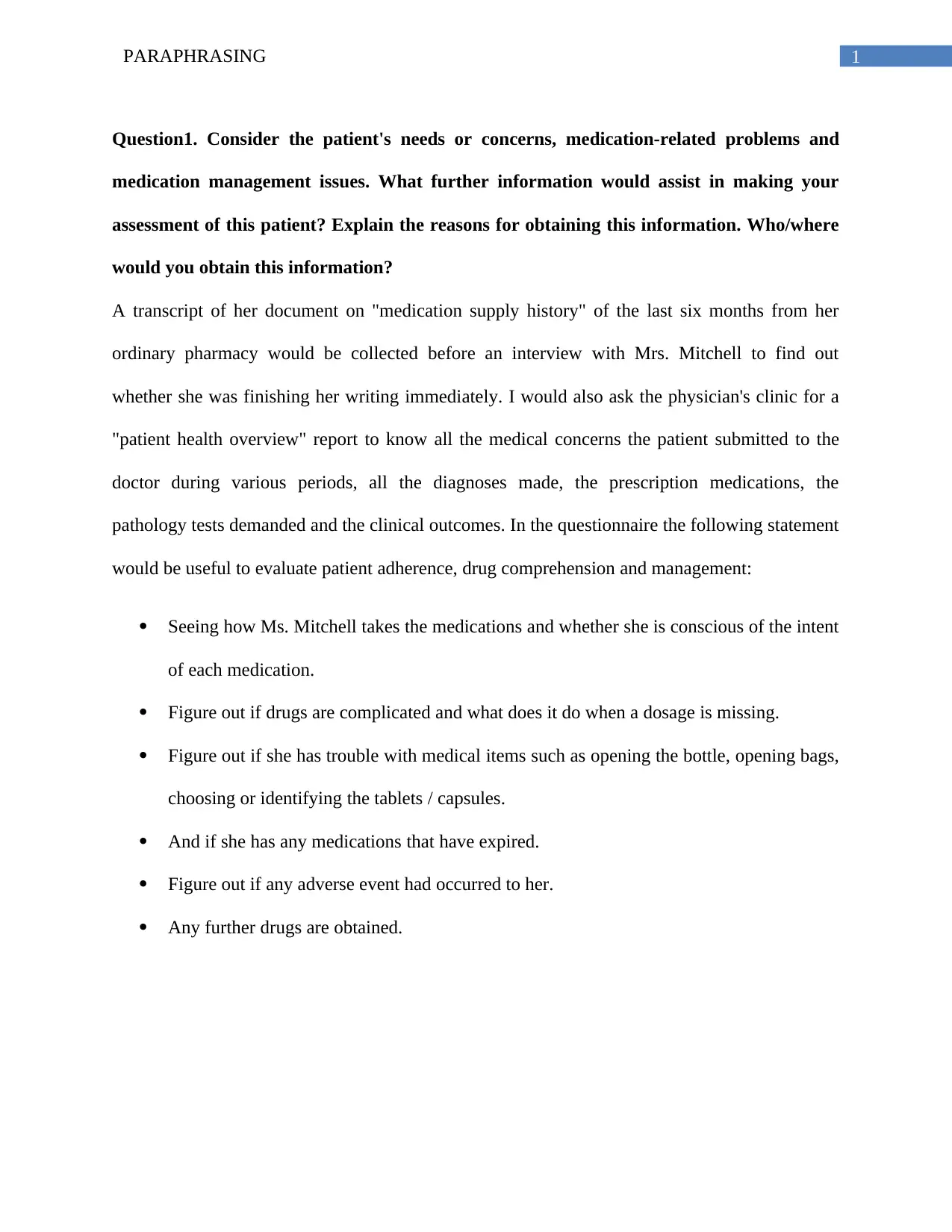
1PARAPHRASING
Question1. Consider the patient's needs or concerns, medication-related problems and
medication management issues. What further information would assist in making your
assessment of this patient? Explain the reasons for obtaining this information. Who/where
would you obtain this information?
A transcript of her document on "medication supply history" of the last six months from her
ordinary pharmacy would be collected before an interview with Mrs. Mitchell to find out
whether she was finishing her writing immediately. I would also ask the physician's clinic for a
"patient health overview" report to know all the medical concerns the patient submitted to the
doctor during various periods, all the diagnoses made, the prescription medications, the
pathology tests demanded and the clinical outcomes. In the questionnaire the following statement
would be useful to evaluate patient adherence, drug comprehension and management:
Seeing how Ms. Mitchell takes the medications and whether she is conscious of the intent
of each medication.
Figure out if drugs are complicated and what does it do when a dosage is missing.
Figure out if she has trouble with medical items such as opening the bottle, opening bags,
choosing or identifying the tablets / capsules.
And if she has any medications that have expired.
Figure out if any adverse event had occurred to her.
Any further drugs are obtained.
Question1. Consider the patient's needs or concerns, medication-related problems and
medication management issues. What further information would assist in making your
assessment of this patient? Explain the reasons for obtaining this information. Who/where
would you obtain this information?
A transcript of her document on "medication supply history" of the last six months from her
ordinary pharmacy would be collected before an interview with Mrs. Mitchell to find out
whether she was finishing her writing immediately. I would also ask the physician's clinic for a
"patient health overview" report to know all the medical concerns the patient submitted to the
doctor during various periods, all the diagnoses made, the prescription medications, the
pathology tests demanded and the clinical outcomes. In the questionnaire the following statement
would be useful to evaluate patient adherence, drug comprehension and management:
Seeing how Ms. Mitchell takes the medications and whether she is conscious of the intent
of each medication.
Figure out if drugs are complicated and what does it do when a dosage is missing.
Figure out if she has trouble with medical items such as opening the bottle, opening bags,
choosing or identifying the tablets / capsules.
And if she has any medications that have expired.
Figure out if any adverse event had occurred to her.
Any further drugs are obtained.
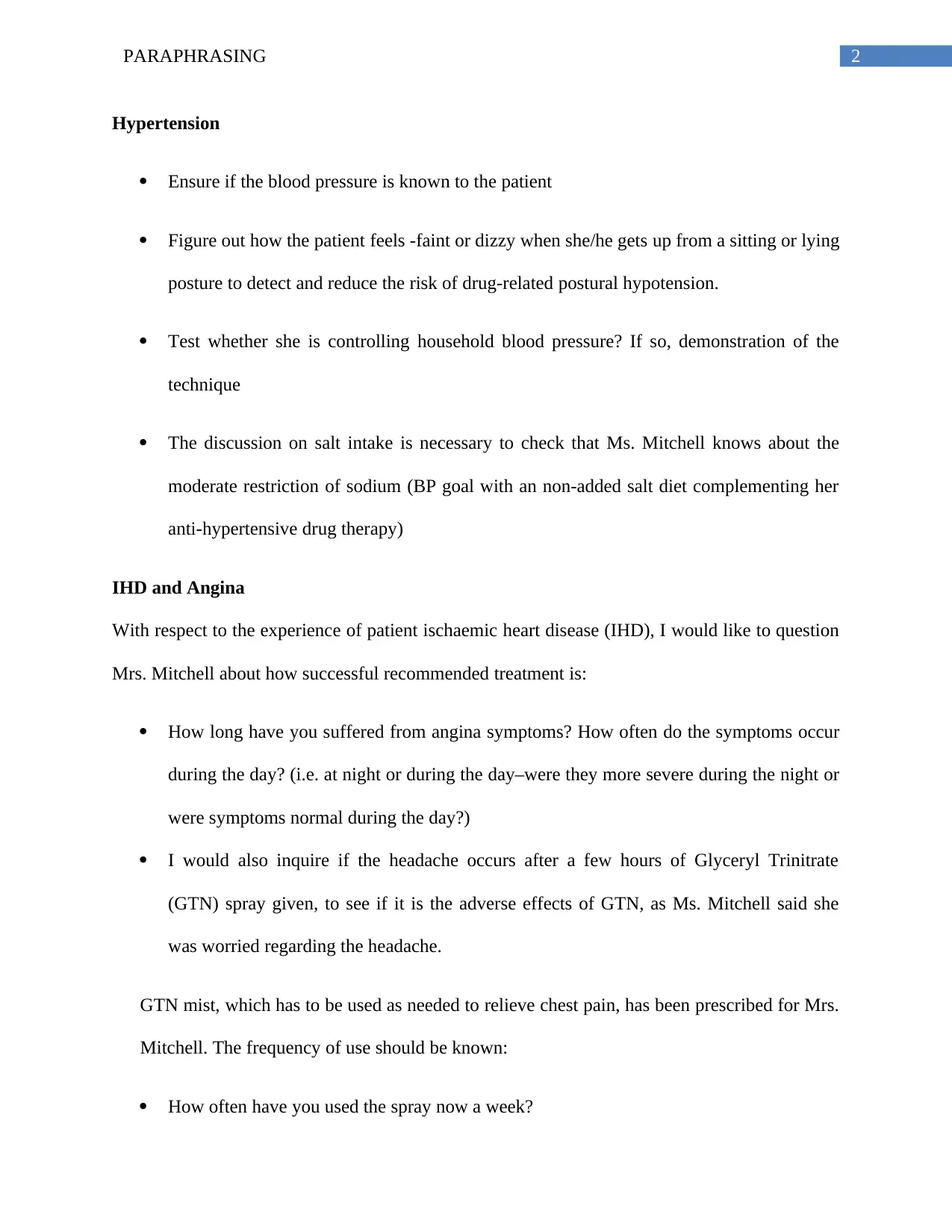
2PARAPHRASING
Hypertension
Ensure if the blood pressure is known to the patient
Figure out how the patient feels -faint or dizzy when she/he gets up from a sitting or lying
posture to detect and reduce the risk of drug-related postural hypotension.
Test whether she is controlling household blood pressure? If so, demonstration of the
technique
The discussion on salt intake is necessary to check that Ms. Mitchell knows about the
moderate restriction of sodium (BP goal with an non-added salt diet complementing her
anti-hypertensive drug therapy)
IHD and Angina
With respect to the experience of patient ischaemic heart disease (IHD), I would like to question
Mrs. Mitchell about how successful recommended treatment is:
How long have you suffered from angina symptoms? How often do the symptoms occur
during the day? (i.e. at night or during the day–were they more severe during the night or
were symptoms normal during the day?)
I would also inquire if the headache occurs after a few hours of Glyceryl Trinitrate
(GTN) spray given, to see if it is the adverse effects of GTN, as Ms. Mitchell said she
was worried regarding the headache.
GTN mist, which has to be used as needed to relieve chest pain, has been prescribed for Mrs.
Mitchell. The frequency of use should be known:
How often have you used the spray now a week?
Hypertension
Ensure if the blood pressure is known to the patient
Figure out how the patient feels -faint or dizzy when she/he gets up from a sitting or lying
posture to detect and reduce the risk of drug-related postural hypotension.
Test whether she is controlling household blood pressure? If so, demonstration of the
technique
The discussion on salt intake is necessary to check that Ms. Mitchell knows about the
moderate restriction of sodium (BP goal with an non-added salt diet complementing her
anti-hypertensive drug therapy)
IHD and Angina
With respect to the experience of patient ischaemic heart disease (IHD), I would like to question
Mrs. Mitchell about how successful recommended treatment is:
How long have you suffered from angina symptoms? How often do the symptoms occur
during the day? (i.e. at night or during the day–were they more severe during the night or
were symptoms normal during the day?)
I would also inquire if the headache occurs after a few hours of Glyceryl Trinitrate
(GTN) spray given, to see if it is the adverse effects of GTN, as Ms. Mitchell said she
was worried regarding the headache.
GTN mist, which has to be used as needed to relieve chest pain, has been prescribed for Mrs.
Mitchell. The frequency of use should be known:
How often have you used the spray now a week?
⊘ This is a preview!⊘
Do you want full access?
Subscribe today to unlock all pages.

Trusted by 1+ million students worldwide
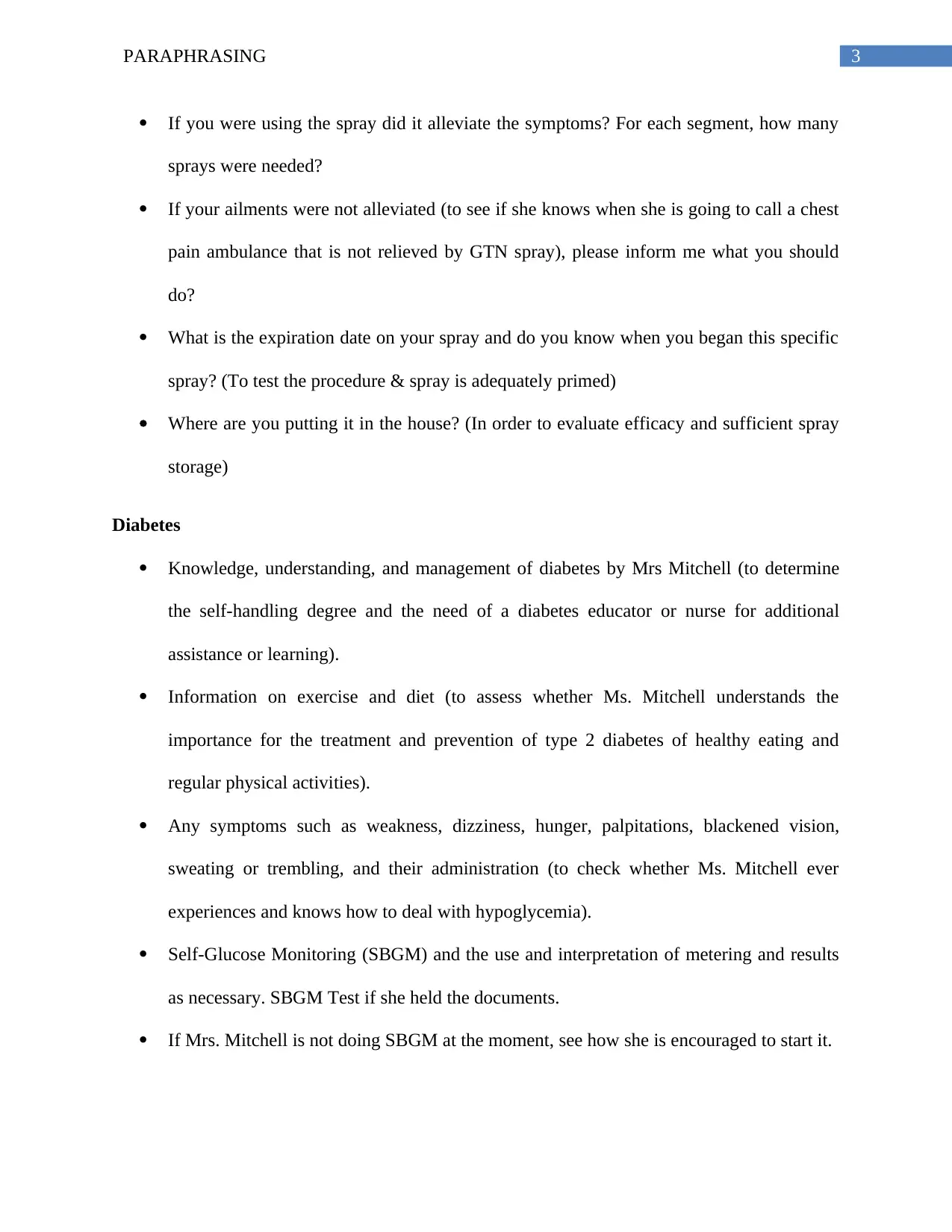
3PARAPHRASING
If you were using the spray did it alleviate the symptoms? For each segment, how many
sprays were needed?
If your ailments were not alleviated (to see if she knows when she is going to call a chest
pain ambulance that is not relieved by GTN spray), please inform me what you should
do?
What is the expiration date on your spray and do you know when you began this specific
spray? (To test the procedure & spray is adequately primed)
Where are you putting it in the house? (In order to evaluate efficacy and sufficient spray
storage)
Diabetes
Knowledge, understanding, and management of diabetes by Mrs Mitchell (to determine
the self-handling degree and the need of a diabetes educator or nurse for additional
assistance or learning).
Information on exercise and diet (to assess whether Ms. Mitchell understands the
importance for the treatment and prevention of type 2 diabetes of healthy eating and
regular physical activities).
Any symptoms such as weakness, dizziness, hunger, palpitations, blackened vision,
sweating or trembling, and their administration (to check whether Ms. Mitchell ever
experiences and knows how to deal with hypoglycemia).
Self-Glucose Monitoring (SBGM) and the use and interpretation of metering and results
as necessary. SBGM Test if she held the documents.
If Mrs. Mitchell is not doing SBGM at the moment, see how she is encouraged to start it.
If you were using the spray did it alleviate the symptoms? For each segment, how many
sprays were needed?
If your ailments were not alleviated (to see if she knows when she is going to call a chest
pain ambulance that is not relieved by GTN spray), please inform me what you should
do?
What is the expiration date on your spray and do you know when you began this specific
spray? (To test the procedure & spray is adequately primed)
Where are you putting it in the house? (In order to evaluate efficacy and sufficient spray
storage)
Diabetes
Knowledge, understanding, and management of diabetes by Mrs Mitchell (to determine
the self-handling degree and the need of a diabetes educator or nurse for additional
assistance or learning).
Information on exercise and diet (to assess whether Ms. Mitchell understands the
importance for the treatment and prevention of type 2 diabetes of healthy eating and
regular physical activities).
Any symptoms such as weakness, dizziness, hunger, palpitations, blackened vision,
sweating or trembling, and their administration (to check whether Ms. Mitchell ever
experiences and knows how to deal with hypoglycemia).
Self-Glucose Monitoring (SBGM) and the use and interpretation of metering and results
as necessary. SBGM Test if she held the documents.
If Mrs. Mitchell is not doing SBGM at the moment, see how she is encouraged to start it.
Paraphrase This Document
Need a fresh take? Get an instant paraphrase of this document with our AI Paraphraser
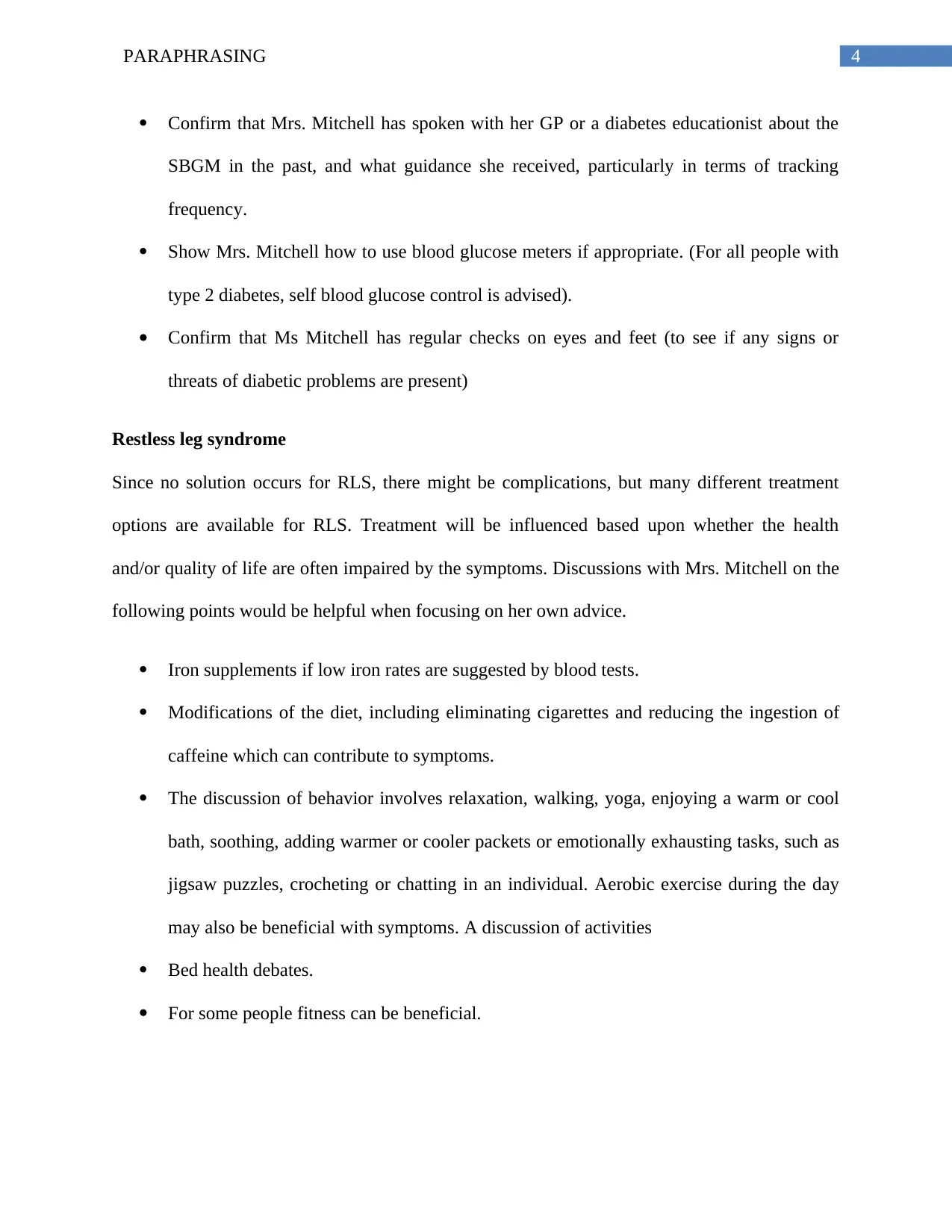
4PARAPHRASING
Confirm that Mrs. Mitchell has spoken with her GP or a diabetes educationist about the
SBGM in the past, and what guidance she received, particularly in terms of tracking
frequency.
Show Mrs. Mitchell how to use blood glucose meters if appropriate. (For all people with
type 2 diabetes, self blood glucose control is advised).
Confirm that Ms Mitchell has regular checks on eyes and feet (to see if any signs or
threats of diabetic problems are present)
Restless leg syndrome
Since no solution occurs for RLS, there might be complications, but many different treatment
options are available for RLS. Treatment will be influenced based upon whether the health
and/or quality of life are often impaired by the symptoms. Discussions with Mrs. Mitchell on the
following points would be helpful when focusing on her own advice.
Iron supplements if low iron rates are suggested by blood tests.
Modifications of the diet, including eliminating cigarettes and reducing the ingestion of
caffeine which can contribute to symptoms.
The discussion of behavior involves relaxation, walking, yoga, enjoying a warm or cool
bath, soothing, adding warmer or cooler packets or emotionally exhausting tasks, such as
jigsaw puzzles, crocheting or chatting in an individual. Aerobic exercise during the day
may also be beneficial with symptoms. A discussion of activities
Bed health debates.
For some people fitness can be beneficial.
Confirm that Mrs. Mitchell has spoken with her GP or a diabetes educationist about the
SBGM in the past, and what guidance she received, particularly in terms of tracking
frequency.
Show Mrs. Mitchell how to use blood glucose meters if appropriate. (For all people with
type 2 diabetes, self blood glucose control is advised).
Confirm that Ms Mitchell has regular checks on eyes and feet (to see if any signs or
threats of diabetic problems are present)
Restless leg syndrome
Since no solution occurs for RLS, there might be complications, but many different treatment
options are available for RLS. Treatment will be influenced based upon whether the health
and/or quality of life are often impaired by the symptoms. Discussions with Mrs. Mitchell on the
following points would be helpful when focusing on her own advice.
Iron supplements if low iron rates are suggested by blood tests.
Modifications of the diet, including eliminating cigarettes and reducing the ingestion of
caffeine which can contribute to symptoms.
The discussion of behavior involves relaxation, walking, yoga, enjoying a warm or cool
bath, soothing, adding warmer or cooler packets or emotionally exhausting tasks, such as
jigsaw puzzles, crocheting or chatting in an individual. Aerobic exercise during the day
may also be beneficial with symptoms. A discussion of activities
Bed health debates.
For some people fitness can be beneficial.
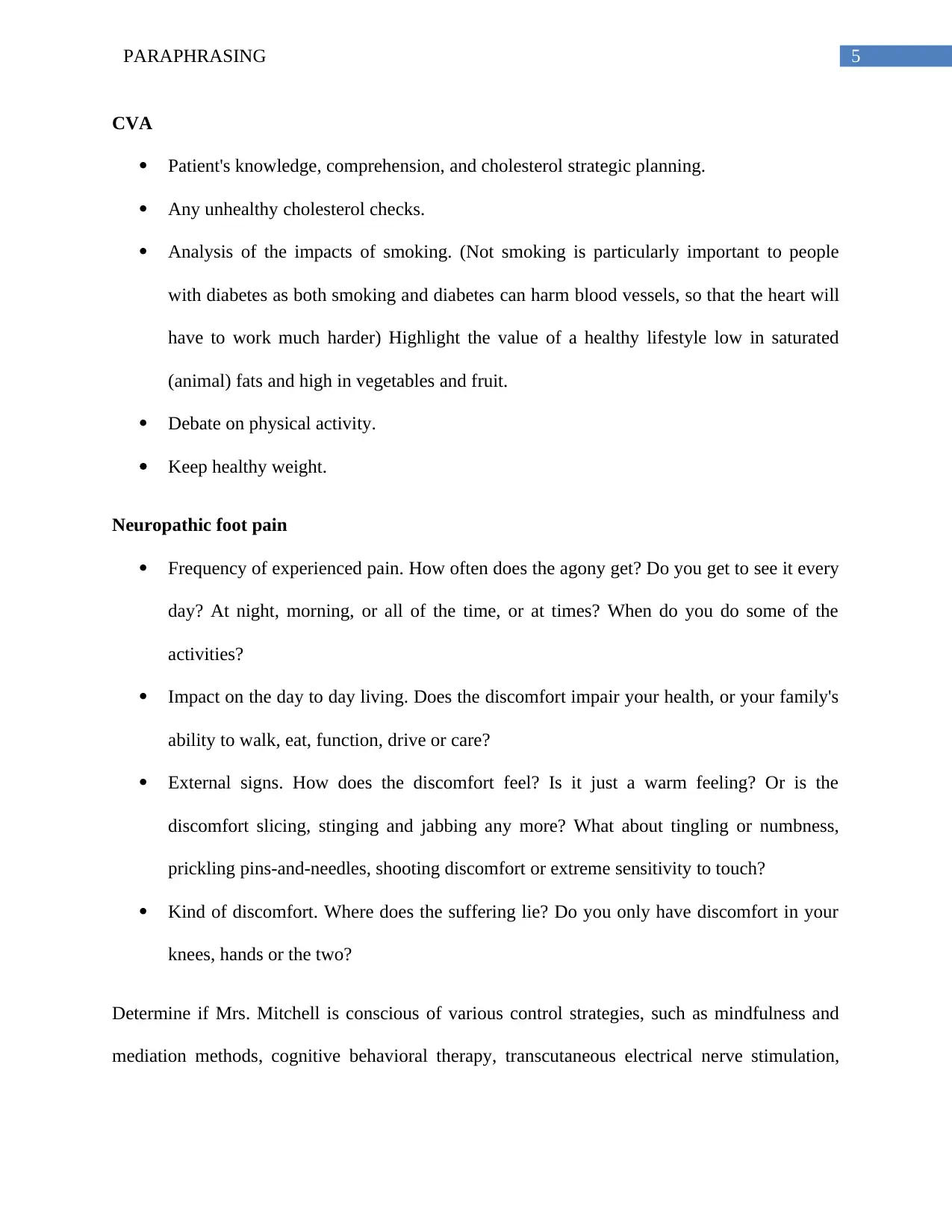
5PARAPHRASING
CVA
Patient's knowledge, comprehension, and cholesterol strategic planning.
Any unhealthy cholesterol checks.
Analysis of the impacts of smoking. (Not smoking is particularly important to people
with diabetes as both smoking and diabetes can harm blood vessels, so that the heart will
have to work much harder) Highlight the value of a healthy lifestyle low in saturated
(animal) fats and high in vegetables and fruit.
Debate on physical activity.
Keep healthy weight.
Neuropathic foot pain
Frequency of experienced pain. How often does the agony get? Do you get to see it every
day? At night, morning, or all of the time, or at times? When do you do some of the
activities?
Impact on the day to day living. Does the discomfort impair your health, or your family's
ability to walk, eat, function, drive or care?
External signs. How does the discomfort feel? Is it just a warm feeling? Or is the
discomfort slicing, stinging and jabbing any more? What about tingling or numbness,
prickling pins-and-needles, shooting discomfort or extreme sensitivity to touch?
Kind of discomfort. Where does the suffering lie? Do you only have discomfort in your
knees, hands or the two?
Determine if Mrs. Mitchell is conscious of various control strategies, such as mindfulness and
mediation methods, cognitive behavioral therapy, transcutaneous electrical nerve stimulation,
CVA
Patient's knowledge, comprehension, and cholesterol strategic planning.
Any unhealthy cholesterol checks.
Analysis of the impacts of smoking. (Not smoking is particularly important to people
with diabetes as both smoking and diabetes can harm blood vessels, so that the heart will
have to work much harder) Highlight the value of a healthy lifestyle low in saturated
(animal) fats and high in vegetables and fruit.
Debate on physical activity.
Keep healthy weight.
Neuropathic foot pain
Frequency of experienced pain. How often does the agony get? Do you get to see it every
day? At night, morning, or all of the time, or at times? When do you do some of the
activities?
Impact on the day to day living. Does the discomfort impair your health, or your family's
ability to walk, eat, function, drive or care?
External signs. How does the discomfort feel? Is it just a warm feeling? Or is the
discomfort slicing, stinging and jabbing any more? What about tingling or numbness,
prickling pins-and-needles, shooting discomfort or extreme sensitivity to touch?
Kind of discomfort. Where does the suffering lie? Do you only have discomfort in your
knees, hands or the two?
Determine if Mrs. Mitchell is conscious of various control strategies, such as mindfulness and
mediation methods, cognitive behavioral therapy, transcutaneous electrical nerve stimulation,
⊘ This is a preview!⊘
Do you want full access?
Subscribe today to unlock all pages.

Trusted by 1+ million students worldwide
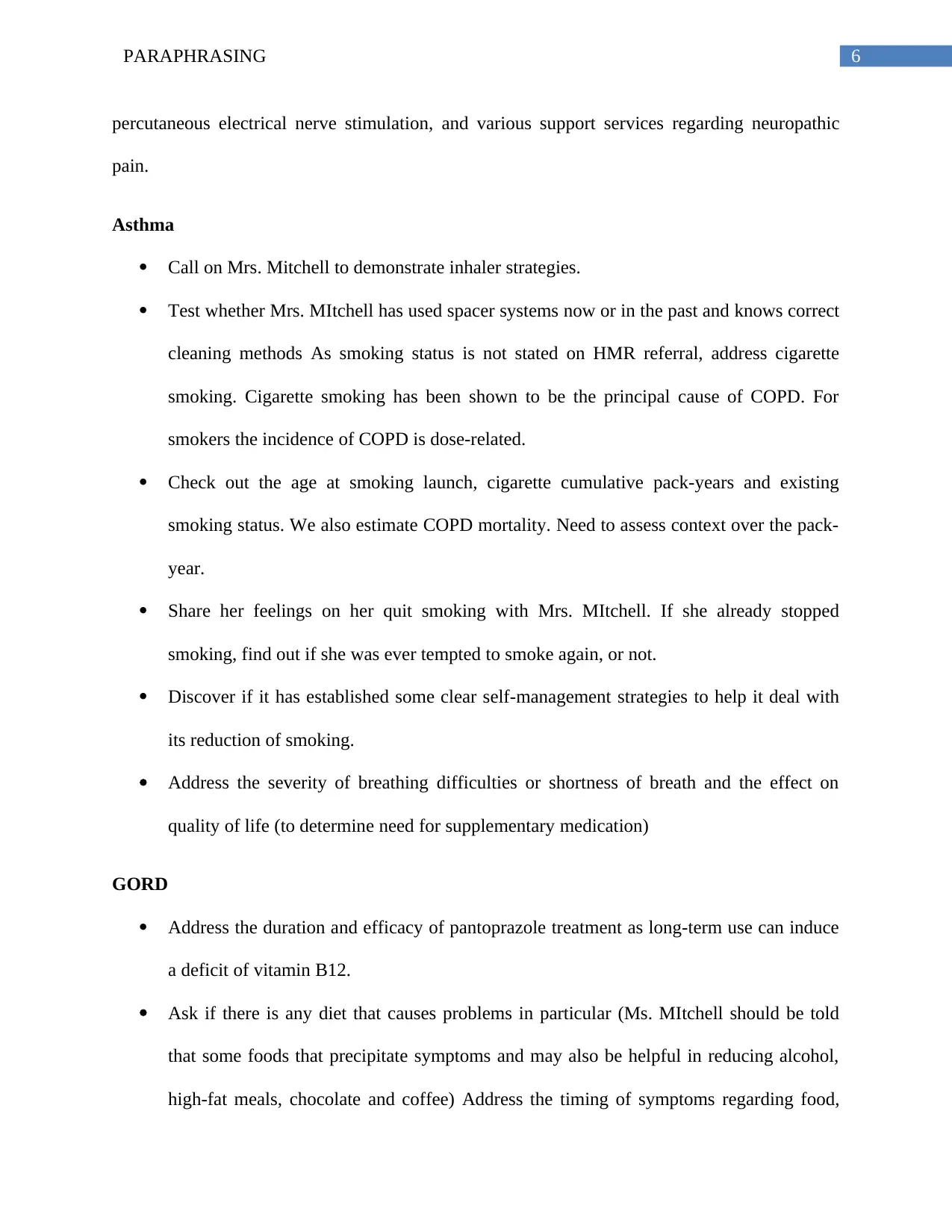
6PARAPHRASING
percutaneous electrical nerve stimulation, and various support services regarding neuropathic
pain.
Asthma
Call on Mrs. Mitchell to demonstrate inhaler strategies.
Test whether Mrs. MItchell has used spacer systems now or in the past and knows correct
cleaning methods As smoking status is not stated on HMR referral, address cigarette
smoking. Cigarette smoking has been shown to be the principal cause of COPD. For
smokers the incidence of COPD is dose-related.
Check out the age at smoking launch, cigarette cumulative pack-years and existing
smoking status. We also estimate COPD mortality. Need to assess context over the pack-
year.
Share her feelings on her quit smoking with Mrs. MItchell. If she already stopped
smoking, find out if she was ever tempted to smoke again, or not.
Discover if it has established some clear self-management strategies to help it deal with
its reduction of smoking.
Address the severity of breathing difficulties or shortness of breath and the effect on
quality of life (to determine need for supplementary medication)
GORD
Address the duration and efficacy of pantoprazole treatment as long-term use can induce
a deficit of vitamin B12.
Ask if there is any diet that causes problems in particular (Ms. MItchell should be told
that some foods that precipitate symptoms and may also be helpful in reducing alcohol,
high-fat meals, chocolate and coffee) Address the timing of symptoms regarding food,
percutaneous electrical nerve stimulation, and various support services regarding neuropathic
pain.
Asthma
Call on Mrs. Mitchell to demonstrate inhaler strategies.
Test whether Mrs. MItchell has used spacer systems now or in the past and knows correct
cleaning methods As smoking status is not stated on HMR referral, address cigarette
smoking. Cigarette smoking has been shown to be the principal cause of COPD. For
smokers the incidence of COPD is dose-related.
Check out the age at smoking launch, cigarette cumulative pack-years and existing
smoking status. We also estimate COPD mortality. Need to assess context over the pack-
year.
Share her feelings on her quit smoking with Mrs. MItchell. If she already stopped
smoking, find out if she was ever tempted to smoke again, or not.
Discover if it has established some clear self-management strategies to help it deal with
its reduction of smoking.
Address the severity of breathing difficulties or shortness of breath and the effect on
quality of life (to determine need for supplementary medication)
GORD
Address the duration and efficacy of pantoprazole treatment as long-term use can induce
a deficit of vitamin B12.
Ask if there is any diet that causes problems in particular (Ms. MItchell should be told
that some foods that precipitate symptoms and may also be helpful in reducing alcohol,
high-fat meals, chocolate and coffee) Address the timing of symptoms regarding food,
Paraphrase This Document
Need a fresh take? Get an instant paraphrase of this document with our AI Paraphraser
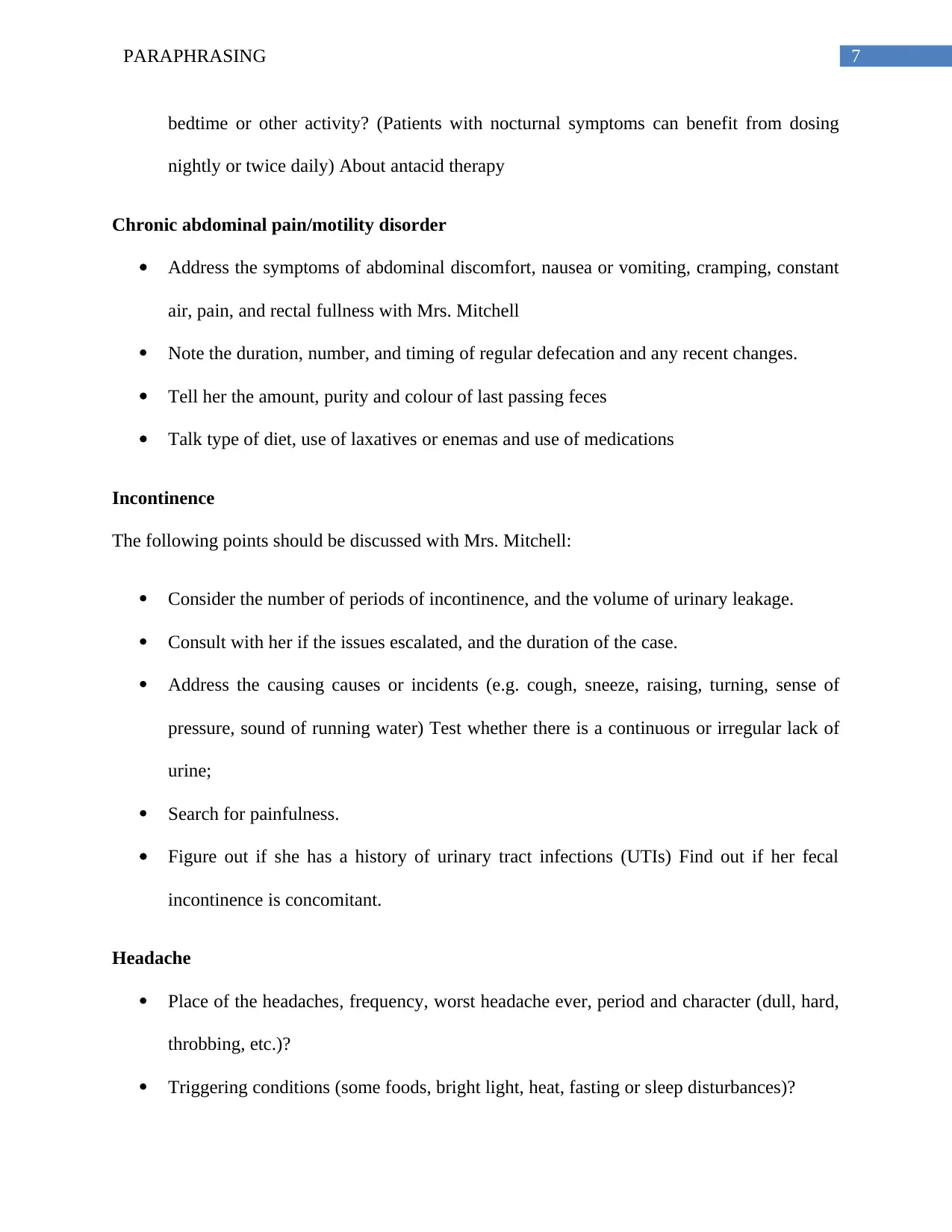
7PARAPHRASING
bedtime or other activity? (Patients with nocturnal symptoms can benefit from dosing
nightly or twice daily) About antacid therapy
Chronic abdominal pain/motility disorder
Address the symptoms of abdominal discomfort, nausea or vomiting, cramping, constant
air, pain, and rectal fullness with Mrs. Mitchell
Note the duration, number, and timing of regular defecation and any recent changes.
Tell her the amount, purity and colour of last passing feces
Talk type of diet, use of laxatives or enemas and use of medications
Incontinence
The following points should be discussed with Mrs. Mitchell:
Consider the number of periods of incontinence, and the volume of urinary leakage.
Consult with her if the issues escalated, and the duration of the case.
Address the causing causes or incidents (e.g. cough, sneeze, raising, turning, sense of
pressure, sound of running water) Test whether there is a continuous or irregular lack of
urine;
Search for painfulness.
Figure out if she has a history of urinary tract infections (UTIs) Find out if her fecal
incontinence is concomitant.
Headache
Place of the headaches, frequency, worst headache ever, period and character (dull, hard,
throbbing, etc.)?
Triggering conditions (some foods, bright light, heat, fasting or sleep disturbances)?
bedtime or other activity? (Patients with nocturnal symptoms can benefit from dosing
nightly or twice daily) About antacid therapy
Chronic abdominal pain/motility disorder
Address the symptoms of abdominal discomfort, nausea or vomiting, cramping, constant
air, pain, and rectal fullness with Mrs. Mitchell
Note the duration, number, and timing of regular defecation and any recent changes.
Tell her the amount, purity and colour of last passing feces
Talk type of diet, use of laxatives or enemas and use of medications
Incontinence
The following points should be discussed with Mrs. Mitchell:
Consider the number of periods of incontinence, and the volume of urinary leakage.
Consult with her if the issues escalated, and the duration of the case.
Address the causing causes or incidents (e.g. cough, sneeze, raising, turning, sense of
pressure, sound of running water) Test whether there is a continuous or irregular lack of
urine;
Search for painfulness.
Figure out if she has a history of urinary tract infections (UTIs) Find out if her fecal
incontinence is concomitant.
Headache
Place of the headaches, frequency, worst headache ever, period and character (dull, hard,
throbbing, etc.)?
Triggering conditions (some foods, bright light, heat, fasting or sleep disturbances)?
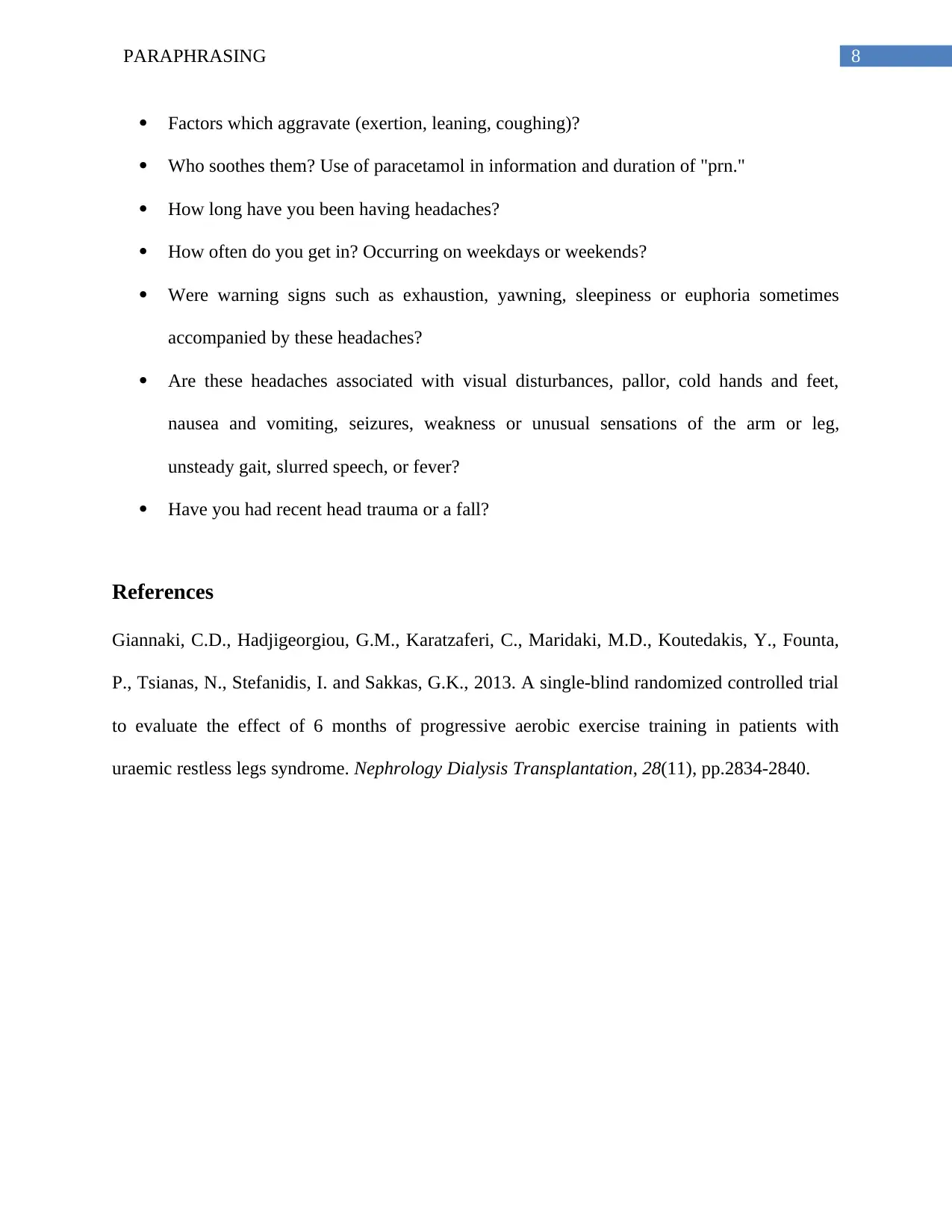
8PARAPHRASING
Factors which aggravate (exertion, leaning, coughing)?
Who soothes them? Use of paracetamol in information and duration of "prn."
How long have you been having headaches?
How often do you get in? Occurring on weekdays or weekends?
Were warning signs such as exhaustion, yawning, sleepiness or euphoria sometimes
accompanied by these headaches?
Are these headaches associated with visual disturbances, pallor, cold hands and feet,
nausea and vomiting, seizures, weakness or unusual sensations of the arm or leg,
unsteady gait, slurred speech, or fever?
Have you had recent head trauma or a fall?
References
Giannaki, C.D., Hadjigeorgiou, G.M., Karatzaferi, C., Maridaki, M.D., Koutedakis, Y., Founta,
P., Tsianas, N., Stefanidis, I. and Sakkas, G.K., 2013. A single-blind randomized controlled trial
to evaluate the effect of 6 months of progressive aerobic exercise training in patients with
uraemic restless legs syndrome. Nephrology Dialysis Transplantation, 28(11), pp.2834-2840.
Factors which aggravate (exertion, leaning, coughing)?
Who soothes them? Use of paracetamol in information and duration of "prn."
How long have you been having headaches?
How often do you get in? Occurring on weekdays or weekends?
Were warning signs such as exhaustion, yawning, sleepiness or euphoria sometimes
accompanied by these headaches?
Are these headaches associated with visual disturbances, pallor, cold hands and feet,
nausea and vomiting, seizures, weakness or unusual sensations of the arm or leg,
unsteady gait, slurred speech, or fever?
Have you had recent head trauma or a fall?
References
Giannaki, C.D., Hadjigeorgiou, G.M., Karatzaferi, C., Maridaki, M.D., Koutedakis, Y., Founta,
P., Tsianas, N., Stefanidis, I. and Sakkas, G.K., 2013. A single-blind randomized controlled trial
to evaluate the effect of 6 months of progressive aerobic exercise training in patients with
uraemic restless legs syndrome. Nephrology Dialysis Transplantation, 28(11), pp.2834-2840.
⊘ This is a preview!⊘
Do you want full access?
Subscribe today to unlock all pages.

Trusted by 1+ million students worldwide
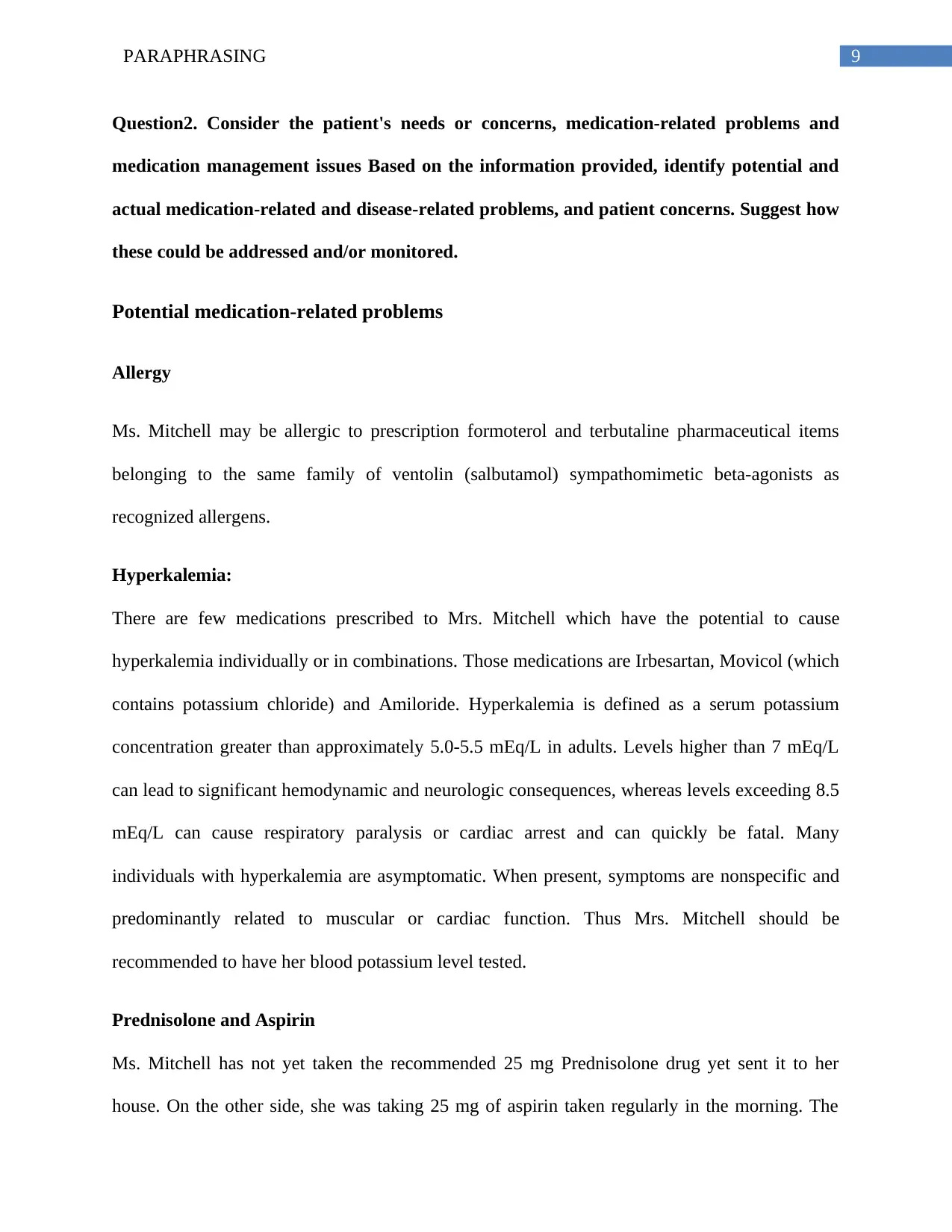
9PARAPHRASING
Question2. Consider the patient's needs or concerns, medication-related problems and
medication management issues Based on the information provided, identify potential and
actual medication-related and disease-related problems, and patient concerns. Suggest how
these could be addressed and/or monitored.
Potential medication-related problems
Allergy
Ms. Mitchell may be allergic to prescription formoterol and terbutaline pharmaceutical items
belonging to the same family of ventolin (salbutamol) sympathomimetic beta-agonists as
recognized allergens.
Hyperkalemia:
There are few medications prescribed to Mrs. Mitchell which have the potential to cause
hyperkalemia individually or in combinations. Those medications are Irbesartan, Movicol (which
contains potassium chloride) and Amiloride. Hyperkalemia is defined as a serum potassium
concentration greater than approximately 5.0-5.5 mEq/L in adults. Levels higher than 7 mEq/L
can lead to significant hemodynamic and neurologic consequences, whereas levels exceeding 8.5
mEq/L can cause respiratory paralysis or cardiac arrest and can quickly be fatal. Many
individuals with hyperkalemia are asymptomatic. When present, symptoms are nonspecific and
predominantly related to muscular or cardiac function. Thus Mrs. Mitchell should be
recommended to have her blood potassium level tested.
Prednisolone and Aspirin
Ms. Mitchell has not yet taken the recommended 25 mg Prednisolone drug yet sent it to her
house. On the other side, she was taking 25 mg of aspirin taken regularly in the morning. The
Question2. Consider the patient's needs or concerns, medication-related problems and
medication management issues Based on the information provided, identify potential and
actual medication-related and disease-related problems, and patient concerns. Suggest how
these could be addressed and/or monitored.
Potential medication-related problems
Allergy
Ms. Mitchell may be allergic to prescription formoterol and terbutaline pharmaceutical items
belonging to the same family of ventolin (salbutamol) sympathomimetic beta-agonists as
recognized allergens.
Hyperkalemia:
There are few medications prescribed to Mrs. Mitchell which have the potential to cause
hyperkalemia individually or in combinations. Those medications are Irbesartan, Movicol (which
contains potassium chloride) and Amiloride. Hyperkalemia is defined as a serum potassium
concentration greater than approximately 5.0-5.5 mEq/L in adults. Levels higher than 7 mEq/L
can lead to significant hemodynamic and neurologic consequences, whereas levels exceeding 8.5
mEq/L can cause respiratory paralysis or cardiac arrest and can quickly be fatal. Many
individuals with hyperkalemia are asymptomatic. When present, symptoms are nonspecific and
predominantly related to muscular or cardiac function. Thus Mrs. Mitchell should be
recommended to have her blood potassium level tested.
Prednisolone and Aspirin
Ms. Mitchell has not yet taken the recommended 25 mg Prednisolone drug yet sent it to her
house. On the other side, she was taking 25 mg of aspirin taken regularly in the morning. The
Paraphrase This Document
Need a fresh take? Get an instant paraphrase of this document with our AI Paraphraser
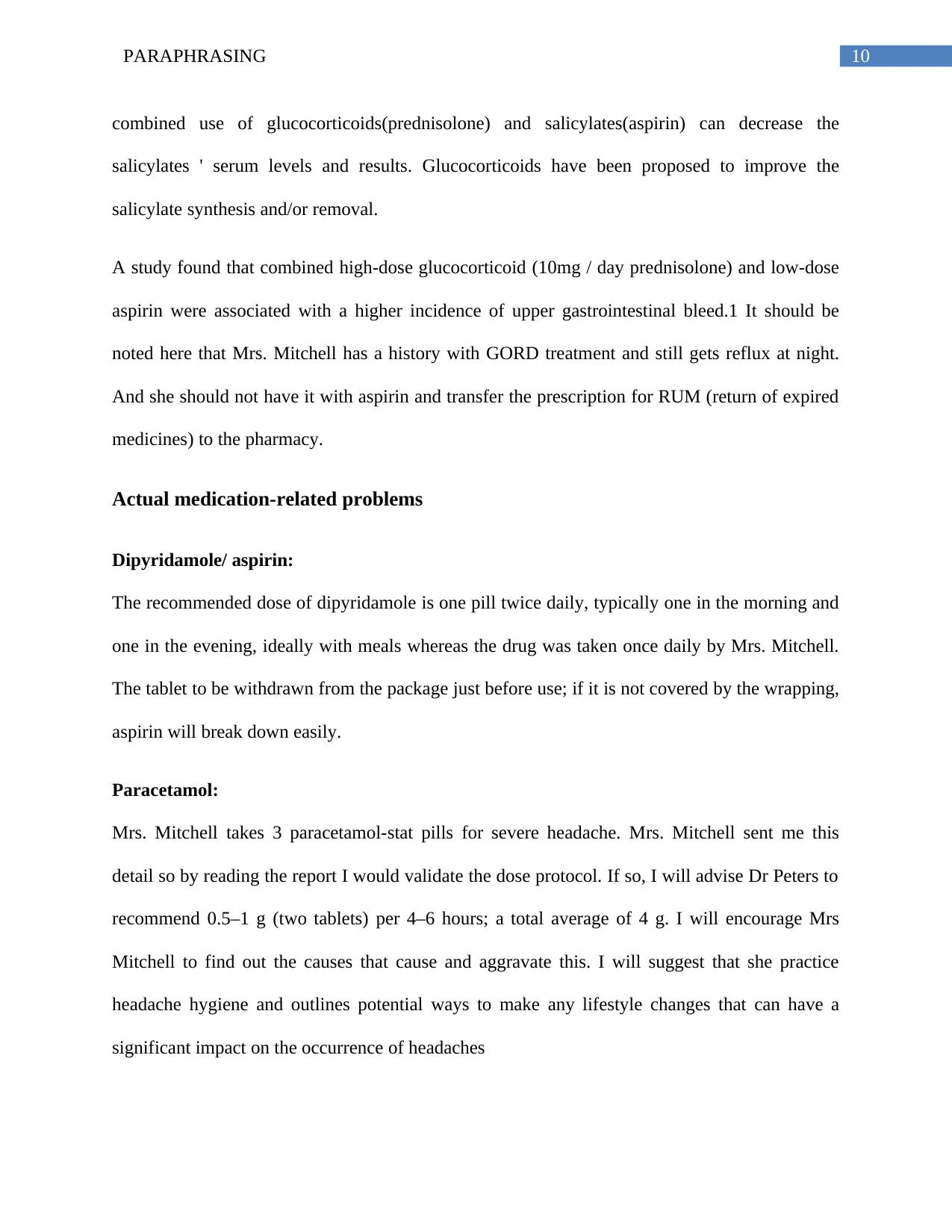
10PARAPHRASING
combined use of glucocorticoids(prednisolone) and salicylates(aspirin) can decrease the
salicylates ' serum levels and results. Glucocorticoids have been proposed to improve the
salicylate synthesis and/or removal.
A study found that combined high-dose glucocorticoid (10mg / day prednisolone) and low-dose
aspirin were associated with a higher incidence of upper gastrointestinal bleed.1 It should be
noted here that Mrs. Mitchell has a history with GORD treatment and still gets reflux at night.
And she should not have it with aspirin and transfer the prescription for RUM (return of expired
medicines) to the pharmacy.
Actual medication-related problems
Dipyridamole/ aspirin:
The recommended dose of dipyridamole is one pill twice daily, typically one in the morning and
one in the evening, ideally with meals whereas the drug was taken once daily by Mrs. Mitchell.
The tablet to be withdrawn from the package just before use; if it is not covered by the wrapping,
aspirin will break down easily.
Paracetamol:
Mrs. Mitchell takes 3 paracetamol-stat pills for severe headache. Mrs. Mitchell sent me this
detail so by reading the report I would validate the dose protocol. If so, I will advise Dr Peters to
recommend 0.5–1 g (two tablets) per 4–6 hours; a total average of 4 g. I will encourage Mrs
Mitchell to find out the causes that cause and aggravate this. I will suggest that she practice
headache hygiene and outlines potential ways to make any lifestyle changes that can have a
significant impact on the occurrence of headaches
combined use of glucocorticoids(prednisolone) and salicylates(aspirin) can decrease the
salicylates ' serum levels and results. Glucocorticoids have been proposed to improve the
salicylate synthesis and/or removal.
A study found that combined high-dose glucocorticoid (10mg / day prednisolone) and low-dose
aspirin were associated with a higher incidence of upper gastrointestinal bleed.1 It should be
noted here that Mrs. Mitchell has a history with GORD treatment and still gets reflux at night.
And she should not have it with aspirin and transfer the prescription for RUM (return of expired
medicines) to the pharmacy.
Actual medication-related problems
Dipyridamole/ aspirin:
The recommended dose of dipyridamole is one pill twice daily, typically one in the morning and
one in the evening, ideally with meals whereas the drug was taken once daily by Mrs. Mitchell.
The tablet to be withdrawn from the package just before use; if it is not covered by the wrapping,
aspirin will break down easily.
Paracetamol:
Mrs. Mitchell takes 3 paracetamol-stat pills for severe headache. Mrs. Mitchell sent me this
detail so by reading the report I would validate the dose protocol. If so, I will advise Dr Peters to
recommend 0.5–1 g (two tablets) per 4–6 hours; a total average of 4 g. I will encourage Mrs
Mitchell to find out the causes that cause and aggravate this. I will suggest that she practice
headache hygiene and outlines potential ways to make any lifestyle changes that can have a
significant impact on the occurrence of headaches
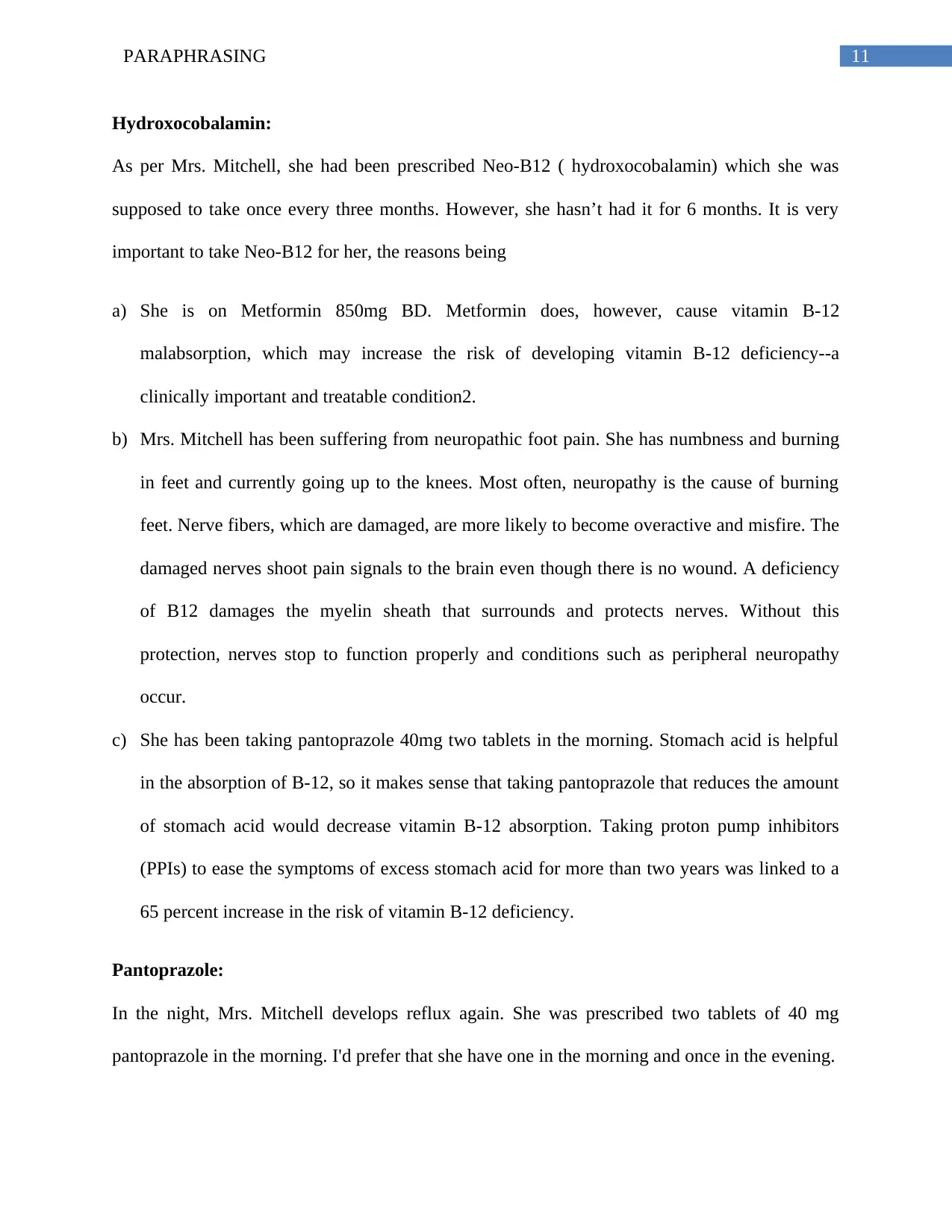
11PARAPHRASING
Hydroxocobalamin:
As per Mrs. Mitchell, she had been prescribed Neo-B12 ( hydroxocobalamin) which she was
supposed to take once every three months. However, she hasn’t had it for 6 months. It is very
important to take Neo-B12 for her, the reasons being
a) She is on Metformin 850mg BD. Metformin does, however, cause vitamin B-12
malabsorption, which may increase the risk of developing vitamin B-12 deficiency--a
clinically important and treatable condition2.
b) Mrs. Mitchell has been suffering from neuropathic foot pain. She has numbness and burning
in feet and currently going up to the knees. Most often, neuropathy is the cause of burning
feet. Nerve fibers, which are damaged, are more likely to become overactive and misfire. The
damaged nerves shoot pain signals to the brain even though there is no wound. A deficiency
of B12 damages the myelin sheath that surrounds and protects nerves. Without this
protection, nerves stop to function properly and conditions such as peripheral neuropathy
occur.
c) She has been taking pantoprazole 40mg two tablets in the morning. Stomach acid is helpful
in the absorption of B-12, so it makes sense that taking pantoprazole that reduces the amount
of stomach acid would decrease vitamin B-12 absorption. Taking proton pump inhibitors
(PPIs) to ease the symptoms of excess stomach acid for more than two years was linked to a
65 percent increase in the risk of vitamin B-12 deficiency.
Pantoprazole:
In the night, Mrs. Mitchell develops reflux again. She was prescribed two tablets of 40 mg
pantoprazole in the morning. I'd prefer that she have one in the morning and once in the evening.
Hydroxocobalamin:
As per Mrs. Mitchell, she had been prescribed Neo-B12 ( hydroxocobalamin) which she was
supposed to take once every three months. However, she hasn’t had it for 6 months. It is very
important to take Neo-B12 for her, the reasons being
a) She is on Metformin 850mg BD. Metformin does, however, cause vitamin B-12
malabsorption, which may increase the risk of developing vitamin B-12 deficiency--a
clinically important and treatable condition2.
b) Mrs. Mitchell has been suffering from neuropathic foot pain. She has numbness and burning
in feet and currently going up to the knees. Most often, neuropathy is the cause of burning
feet. Nerve fibers, which are damaged, are more likely to become overactive and misfire. The
damaged nerves shoot pain signals to the brain even though there is no wound. A deficiency
of B12 damages the myelin sheath that surrounds and protects nerves. Without this
protection, nerves stop to function properly and conditions such as peripheral neuropathy
occur.
c) She has been taking pantoprazole 40mg two tablets in the morning. Stomach acid is helpful
in the absorption of B-12, so it makes sense that taking pantoprazole that reduces the amount
of stomach acid would decrease vitamin B-12 absorption. Taking proton pump inhibitors
(PPIs) to ease the symptoms of excess stomach acid for more than two years was linked to a
65 percent increase in the risk of vitamin B-12 deficiency.
Pantoprazole:
In the night, Mrs. Mitchell develops reflux again. She was prescribed two tablets of 40 mg
pantoprazole in the morning. I'd prefer that she have one in the morning and once in the evening.
⊘ This is a preview!⊘
Do you want full access?
Subscribe today to unlock all pages.

Trusted by 1+ million students worldwide
1 out of 30
Your All-in-One AI-Powered Toolkit for Academic Success.
+13062052269
info@desklib.com
Available 24*7 on WhatsApp / Email
![[object Object]](/_next/static/media/star-bottom.7253800d.svg)
Unlock your academic potential
Copyright © 2020–2025 A2Z Services. All Rights Reserved. Developed and managed by ZUCOL.

